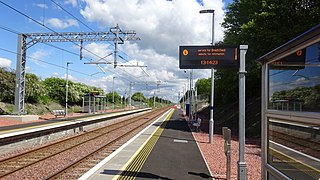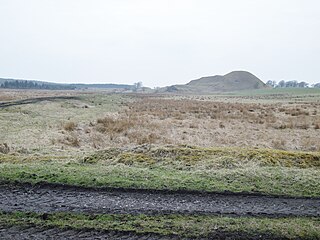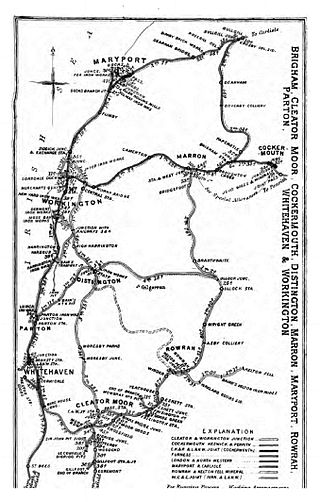
Pontyclun railway station is an unstaffed, minor railway station in Pontyclun, in the County Borough of Rhondda Cynon Taf, South Wales. The station is at street level, on Station Approach, Pontyclun. It is a stop on the South Wales Main Line, served by trains on the Maesteg Line, and occasionally by the Swanline Cardiff to Swansea regional services, as well as one early-morning daily service to Manchester and a late-night daily service to Carmarthen. The station and all trains are operated by Transport for Wales Rail. It is 181 miles 40 chains (292.1 km) from the zero point at London Paddington, measured via Stroud.

Breich railway station is a rural railway station serving the village of Breich in West Lothian, Scotland. It is located on the Shotts Line, 21 miles (34 km) west of Edinburgh Waverley towards Glasgow Central. It was the sixth-least-used station in the UK until 2018-19 and was the second-least-used in Scotland, after Barry Links as well as being the least used station in West Lothian.

Stockton is a railway station on the Durham Coast Line, which runs between Newcastle and Middlesbrough via Hartlepool. The station, situated 5 miles 45 chains (9.0 km) west of Middlesbrough, serves the market town of Stockton-on-Tees in County Durham, England. It is owned by Network Rail and managed by Northern Trains.

Uddingston railway station serves the small town of Uddingston, South Lanarkshire, Scotland. ScotRail provides passenger services to this station on the Argyle Line and Shotts Line.

Auchengray railway station was just outside Auchengray, a hamlet in the Parish of Carnwath, South Lanarkshire, Scotland. It was served by local trains on what is now known as the West Coast Main Line.
The Rutherglen and Coatbridge Railway was a railway line in Scotland built by the Caledonian Railway to shorten the route from the Coatbridge area to Glasgow. It opened in 1865. It was later extended to Airdrie in 1886, competing with the rival North British Railway. Soon after a further extension was built from Airdrie to Calderbank and Newhouse.

Arkwright Town railway station was in Arkwright Town, Derbyshire, England.
The Wilsontown, Morningside and Coltness Railway was a railway opened in 1845, primarily for mineral traffic, although a passenger service was run sporadically. The line ran from a junction with the Wishaw and Coltness Railway at Chapel, to Longridge, in South Central Scotland, and it was extended to Bathgate in 1850 after takeover by the Edinburgh and Glasgow Railway. It was built to open up further coal deposits and to connect the Wilsontown Ironworks, although it did not actually reach Wilsontown. In common with the other "coal railways" with which it connected, it adopted the track gauge of 4 ft 6 in, often referred to as Scotch gauge.

The Durham to Bishop Auckland Line was a railway line originally built by the North Eastern Railway (NER) to provide rail transport access to coal mines in West County Durham. It closed under the Beeching Axe to passenger traffic in May 1964, and freight in 1968. Today it forms the major part of the 9 miles (14 km) Brandon to Bishop Auckland rail trail.
This article traces the Caledonian Railway branches in South Lanarkshire.
The Caledonian Railway lines to Edinburgh started with the main line that reached Edinburgh in 1848 as part of its route connecting the city with Glasgow and Carlisle. The potential of the docks at Granton and Leith led to branch line extensions, and residential development encouraged branch lines in what became the suburbs of Edinburgh. In 1869 a line was opened from Carfin through Shotts giving the Caledonian a shorter route between Glasgow and Edinburgh.

Longridge railway station was the original terminus of the Wilsontown, Morningside and Coltness Railway (WM&CR) that served the nearby village of Longridge in West Lothian and it was also referred to as Eastern station and was 8 miles 50 chains (13.9 km) from Morningside station.

Headless Cross railway station or Headlesscross railway station was a station on the Wilsontown, Morningside and Coltness Railway (WM&CR) that served the rural area of Headless Cross near Fauldhouse in West Lothian. The station was located 4 miles 60 chains east of Morningside railway station.
Davies Dyke railway station or Daviesdyke railway station was a station on the Wilsontown, Morningside and Coltness Railway (WM&CR) that served the rural area of Davies Dyke near Allanton in Lanarkshire, Parish of Cambusnethan. The station was located 1 miles 60 chains east of Morningside railway station.

Crofthead railway station or Fauldhouse and Crofthead was a station on the Wilsontown, Morningside and Coltness Railway (WM&CR) that served the area of Crofthead and its miners rows, Greenburn and Gowanbrae near Fauldhouse in West Lothian. The station was located 7 miles 40 chains east of Morningside railway station.

The Harrington and Lowca Light Railway was a short railway on the coast of Cumberland, which is now part of Cumbria, England.
Drum railway station was opened in January 1854 by the Deeside Railway and served the rural area around Drum Castle estate. The Deeside Railway was taken over by the GNoSR and in 1894 nearby Culter became the terminus for the majority of Aberdeen suburban services with only a few trains continuing through Drum to Banchory. Despite the 1937 closure of many other stations on the Aberdeen suburban service, Drum remained open until 1951 as an intermediate station on the Deeside Railway that ran from Aberdeen (Joint) to Ballater. Drum station was located in Drumoak Parish, Aberdeenshire, Scotland.

Park railway station was opened in September 1853 by the Deeside Railway and served the rural area around the Park estate, Nether Sunnyside, West Redford and the hamlet of Park. The Deeside Railway was taken over by the GNoSR and in 1894 nearby Culter became the terminus for the majority of Aberdeen suburban services with only a few trains continuing through Park to Banchory. Despite the 1937 closure of many other stations on the Aberdeen suburban service, Park remained open until 1966 as an intermediate station on the Deeside Railway that ran from Aberdeen (Joint) to Ballater. Park station was located in Drumoak Parish, Aberdeenshire, Scotland.
Maryville railway station (NS687620) was opened in 1878 at Maryville, a small community in the Uddingston area to the south-east of Glasgow, Scotland on the old Glasgow, Bothwell, Hamilton and Coatbridge Railway between Shettleston and Hamilton. Clydeside and Bredisholm collieries were also served by the station.

Wilsontown railway station was the passenger terminus of the three and three quarter mile long Wilsontown Branch that ran from a bay platform at Auchengray railway station and served the nearby village of Wilsontown in Lanarkshire and several collieries. The only other station on the line was at Haywood, standing two miles from Auchengray on a double track section of the line. Apart from the collieries this was a mainly farming district at the times of the railway's construction.














